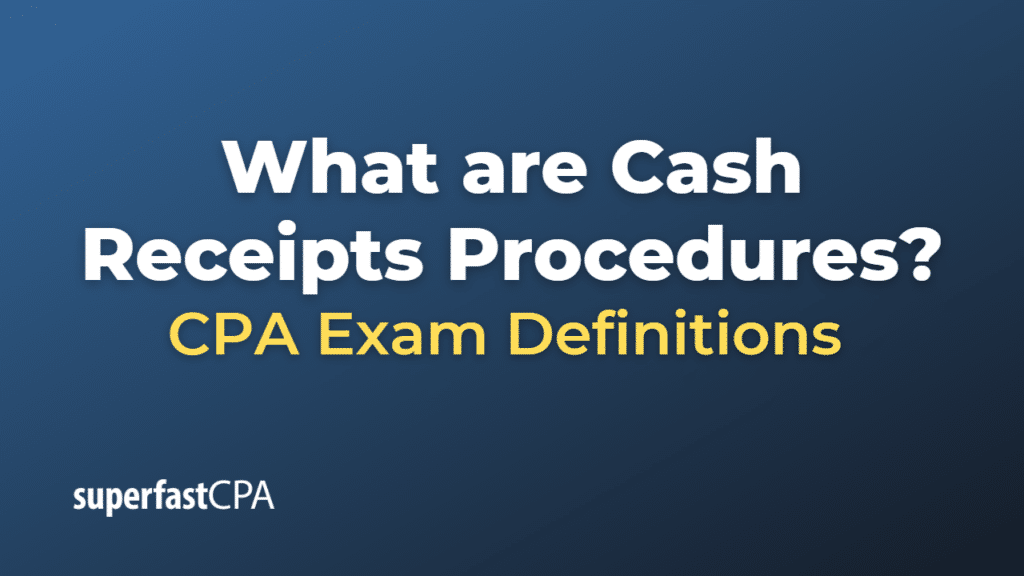Cash Receipts Procedures
Cash receipts procedures are the steps and controls that a business implements to manage and process cash inflows effectively and securely. These procedures help ensure that all cash received is accurately recorded, deposited, and reconciled, minimizing the risk of errors, theft, or fraud. Here are some common cash receipts procedures:
- Segregation of duties: Assign different tasks related to cash handling, recording, and depositing to different employees to reduce the risk of misappropriation or fraud.
- Proper authorization: Require authorization for certain transactions, such as cash refunds, voided sales, or adjustments to accounts receivable.
- Secure cash storage: Store cash in a secure location, such as a locked cash drawer or safe, and limit access to authorized personnel.
- Timely deposits: Deposit cash receipts into the bank account on a regular basis (daily or weekly) to reduce the risk of theft or loss.
- Receipt documentation: Issue receipts for all cash transactions, and maintain copies of the receipts for record-keeping purposes.
- Cash receipts journal: Record all cash receipts in a cash receipts journal, including the date, description, invoice number (if applicable), and the amount received.
- Reconciliation: Periodically reconcile cash receipts records with bank statements and general ledger accounts to identify discrepancies and ensure accurate financial reporting.
- Internal and external audits: Conduct periodic internal audits to review cash handling procedures, and engage external auditors for independent verification of cash records and controls.
- Employee training: Train employees responsible for handling cash on the proper procedures and controls, and emphasize the importance of accuracy, security, and ethical behavior.
- Continuous improvement: Regularly review and update cash receipts procedures to adapt to changes in the business environment, technology, or regulatory requirements, and to address any identified weaknesses or inefficiencies.
By implementing effective cash receipts procedures, businesses can better manage their cash inflows, maintain accurate financial records, and reduce the risk of errors or fraud.
Example of Cash Receipts Procedures
Let’s consider a small retail store as an example for implementing cash receipts procedures:
- Segregation of duties: The store owner assigns the cashier to handle cash transactions and issue receipts, while the store manager is responsible for depositing cash into the bank and recording transactions in the cash receipts journal.
- Proper authorization: The store manager must approve any cash refunds or voided sales, and they are responsible for reviewing and approving any adjustments to accounts receivable.
- Secure cash storage: The cashier keeps the cash in a locked cash drawer during business hours, and the store manager stores the cash in a safe overnight.
- Timely deposits: The store manager deposits cash receipts into the bank account daily to minimize the risk of theft or loss.
- Receipt documentation: The cashier issues receipts to customers for all cash transactions and maintains copies of the receipts for record-keeping purposes.
- Cash receipts journal: The store manager records all cash receipts in a cash receipts journal, including the date, description, invoice number (if applicable), and the amount received.
- Reconciliation: The store owner reconciles cash receipts records with bank statements and general ledger accounts monthly to identify discrepancies and ensure accurate financial reporting.
- Internal and external audits: The store owner conducts periodic internal audits to review cash handling procedures and hires an external auditor to conduct an annual audit of cash records and controls.
- Employee training: The store owner provides training to the cashier and store manager on proper cash handling procedures and emphasizes the importance of accuracy, security, and ethical behavior.
- Continuous improvement: The store owner regularly reviews and updates cash receipts procedures, addressing any identified weaknesses or inefficiencies and adapting to changes in the business environment or regulatory requirements.
By implementing these cash receipts procedures, the retail store can effectively manage its cash inflows, maintain accurate financial records, and reduce the risk of errors or fraud.













